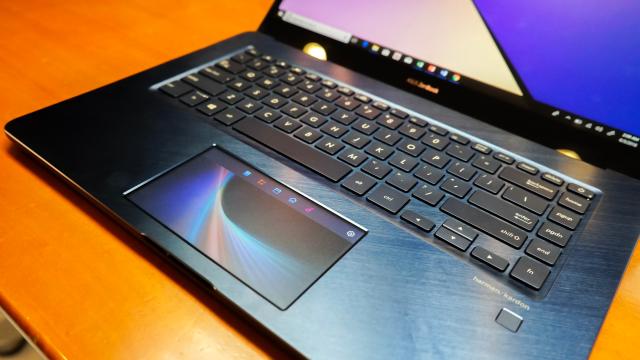For years, advancements in the humble laptop touchpad have ranged from “it’s almost as good as a Macbook” to choosing whether to hide the left and right buttons.
It’s the bit of tech laptops take for granted, in many ways. But ASUS is having a crack at turning the touchpad into something more: namely, a second screen.
It’s called the ScreenPad, although when you first play around with the new ZenBook it functions like your everyday, ordinary touchpad. You can leave it that way, or disable the touchpad entirely, by pressing F6. But it’s the app functionality, and the second screen function, that makes ScreenPad pretty neat.
The first mode, pictured in the short video above, uses the touchpad as a screen for supporting apps. They’ll be made available through the Windows Store, and ASUS told press that an SDK would be made available in the third quarter of the year.
A hands-on session was held under embargo ahead of the ASUS conference today, where press got a chance to mess around with the ScreenPad’s functionality. The preloaded apps are fairly straightforward to begin with: a background you can customise with any image of your choice, a calendar (that hooks into your Microsoft account), a calculator and a custom music player.
There is support for Spotify, according to the reviewers’ guide that was open on one of the laptops, although I didn’t see that functionality at ASUS HQ. You can also just set the ScreenPad to work as a numpad, which solves the thorny issue of having to wedge the numpad into the keyboard layout.
More importantly, and much more fun, is the ability to do this:
Yup, that’s a full working Chrome browser. With a quick press of a function key, or the old fashioned Windows + P shortcut, you can set the ScreenPad as a second screen, duplicate your existing display, or disable it entirely. (Hitting F6 will also swap between traditional touchpad/second screen/app functionality modes, as mentioned before.)
A shot of the ZenBook 15 in action, with an Overwatch League video playing in the bottom screen.
While the touchpad is on the larger size, you’re still shrinking an entire desktop down to the size of a small screen. You’ll need to use a larger – probably black – mouse cursor if you wanted to use the touchpad like this consistently, but having the functionality is real neat.
Another cool feature: the ScreenPad can also provide contextual help within certain apps. In Microsoft Office, for instance, the touchpad can turn into a mini toolbar allowing you to apply basic functions, italics, and other useful info at the touch of a button:
That said, the idea’s cooler than the reality. In my limited testing, the toolbar took over a minute to open after I’d already loaded Microsoft Excel. There was also a huge amount of lag, making it faster to apply changes the old-fashioned way. I wasn’t able to give the rest of the Office suite a try to see if performance was similarly challenged across the board, though.
The ZenBook Pro 15’s raw hardware, however, won’t have any troubles powering the ScreenPad as a second screen. ASUS showed off a model with an i9-8950HK, 16GB of 2400Mhz DDR4 RAM, a GTX 1050 Ti and a 15.6″ 4K screen. There’s a 15.6″ 1080p model as well, but as far as the 4K screen is concerned the panel covers 132% coverage of the sRGB gamut, 100% coverage of Adobe RGB, and has a Delta E accuracy of under 2.
(There was a fun moment during the conference where ASUS ran a live test of the screen to illustrate its potential. The first runs all returned delta values of 30 or more, until someone realised the testing equipment was facing the crowd and not the monitor.)
The ZenBook 15 Pro also has a model with an i5-8300H and an i7-8750H. The baseline storage options start from a 256GB SATA 3 SSD and 512GB NVMe PCIe M.2 SSDs and go up to 512GB/1TB respectively.
You won’t be able to buy the i5 version in Australia, but the i7-8750H will start from $2999 and ship with 512GB storage, 16GB RAM and a GTX 1050. Pricing and availability for the i9 model isn’t available yet, and we’ll keep you posted when the i7 model hits our shores.
The author travelled to Computex 2018 as a guest of ASUS.
